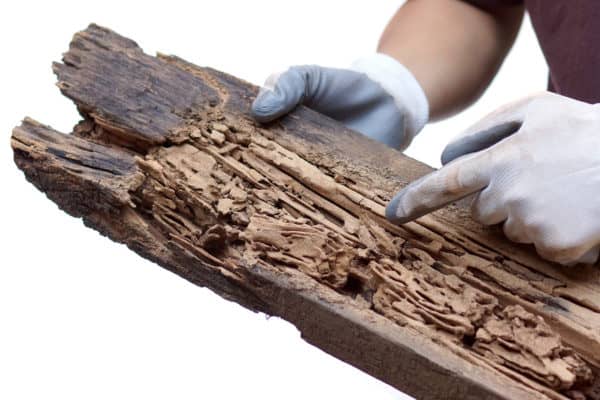Termites cause billions of dollars in damage each year. There are two main types of termites: drywood termites and subterranean termites. Drywood termites are found in warm, southern climates. They establish their colonies deep within the wood that they eat. As they consume wood, they create mazes of tunnels and chambers within the walls and foundation of your home. Subterranean termites are found throughout the continental United States. These termites build their colonies underground and emerge in search of food. They can enter your home through cracked or unsealed foundations.
Because termites eat wood from the inside out, termite damage often goes undetected for long periods of time. Often in fact, by the time signs of termites appear, colonies are well established and significant damage has already been done. Because of this, it is recommended that you get a termite inspection at least once per year or any time you find signs of termite activity. The average termite inspection cost is usually free (if no termite report is required, as in the case of a real estate transaction), or can be anywhere from $45 to over $100 depending on the size of your home and the exterminating company hired. A licensed termite inspector will perform a visible inspection on the readily accessible areas of your home looking for evidence of termites. The inspection should include a visual inspection of the entire interior of the home (including crawlspace and basement) and the exterior of the property. If evidence of termites are found, a termite exterminator will be required to provide appropriate termite control options and treatment.
Spotting signs of termites is a good indicator that a well established colony is nearby. But what are these signs? What should you look for? Here are 6 common signs of termites:
- Sounds: Soldier termites will bang their heads against wood or shake their bodies when the colony is disturbed. They use these sounds to signal danger to the other termites in the colony. The sound is often heard as a quiet clicking sound emanating from the walls.
- Wings: Flying termites are usually the first sign of a termite infestation. While they are often mistaken for flying ants, they are, in fact, “swarmers” who leave the nest in search of a mate to establish a new colony. Swarming season is usually in the spring after the first freeze. Once the termites mate, they lose their wings. These discarded wings, often found near doors and windowsills, are another common sign of termites.
- Warping: Termites produce moisture when they tunnel through wood. When they make their way through window frames and doors it causes them to warp, making them difficult to get open, often resembling water damage. This can also cause uneven or bubbling paint.
- Wood Damage: Termites consume wood from the inside out, sometimes masking damage for long periods of time. When wood is damaged by termites, it will often make a hollow or papery sound when tapped on. This is one of the most common signs of termite damage.
- Frass: Frass is another name for termite feces. Subterranean termites use their feces to build tunnels; drywood termites, however, push their feces out of small holes near the entrances to their nests as they tunnel. This leaves small black marks and a dark powdery substance near sites of infestation and damage. Frass is often found as piles of pellets.
- Mud Tubes: Subterranean termites build mud tubes to provide moisture and protect them from predators while they travel between their colonies and their food sources. These tubes are often found near home foundations. Mud tubes are made of tiny pieces of soil, wood, and debris.
If you suspect you have a termite problem or if you spot signs of a termite infestation, contact a professional termite control company who can provide you with a thorough termite inspection and a comprehensive termite protection and treatment plan.
You May Also Be Interested In:
Summer Wildlife Removal: Common Home Invaders
What Are These Little Black Ants?

